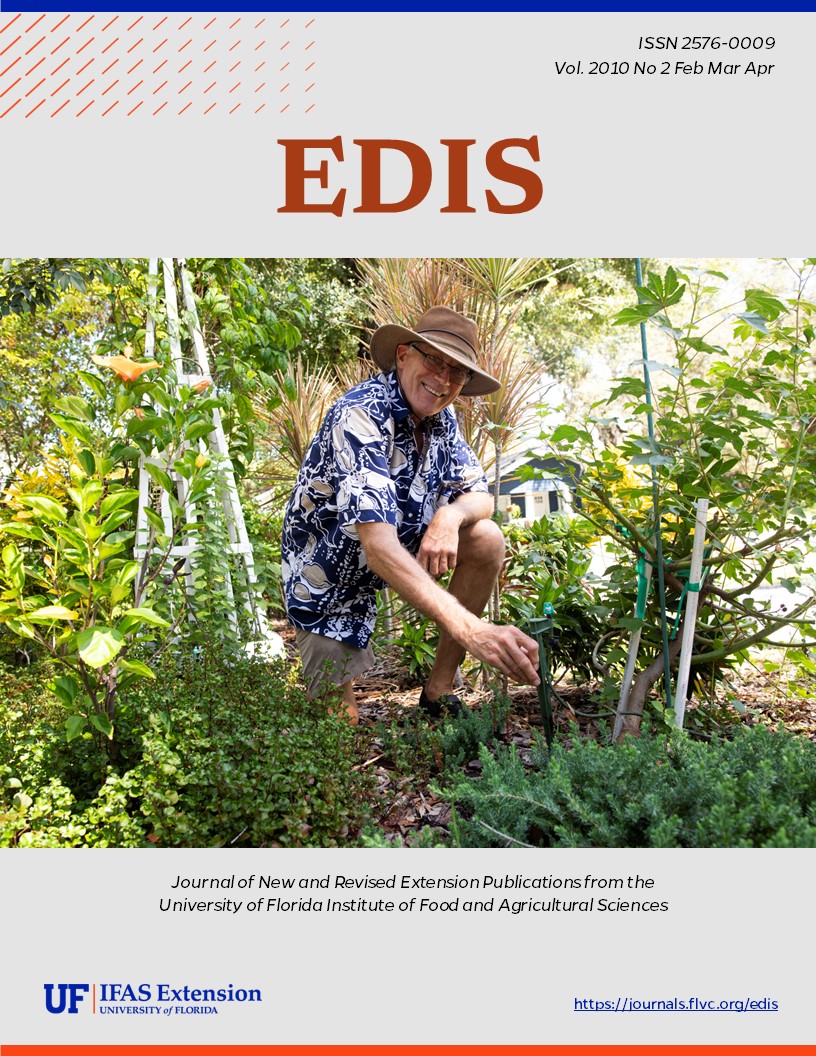Abstract
ENH1155, an 8-page illustrated fact sheet by Karen V. S. Hupp, Alison M. Fox, Sandra B. Wilson, Emily L. Barnett, and Randall K. Stocker, describes this herbaceous perennial that is popular with consumers, landscapers, and growers — its preferred habitat, dispersal, hybridization, cultivars, invasive status and distribution in natural areas, IFAS Assessment, and control. Includes references. Published by the UF Department of Environmental Horticulture, December 2009.
ENH1155/EP415: Natural Area Weeds: Mexican Petunia (Ruellia simplex) (ufl.edu)
References
Ezcurra, C. and T.F. Daniel. 2007. Ruellia simplex, an older and overlooked name for Ruellia tweedinana and Ruellia coerulea (Acanthaceae). Darwiniana 45:201-203.
Florida Exotic Pest Plant Council. 2007a. Early detection and distribution mapping system. http://www.fleppc.org/list/07List.htm. Accessed: June 2009.
Florida Exotic Pest Plant Council. 2007b. Florida Exotic Pest Plant Council's 2007 list of invasive species. http://www.fleppc.org/EDDMapS/florida.cfm. Accessed: August 2009.
Florida Department of Environmental Protection (FDEP). 1998. Florida Wetland Plants: An Identification Manual. University of Florida, IFAS, Gainesville, FL. p. 228.
Fox, A.M., D.R. Gordon, J.A. Dusky, L. Tyson and R.K. Stocker. 2008. Institute of Food and Agricultural Sciences (IFAS) assessment of non-native plants in Florida's natural areas-status assessment. http://plants.ifas.ufl.edu/assessment.html. Accessed: July 2009. https://doi.org/10.32473/edis-ag234-2009
Gann, G.D., K.A. Bradley, and S.W. Woodmansee. 2008. The Floristic inventory of south Florida database online. http://regionalconservation.org/ircs/index.asp. Accessed: June 2009.
Gilman, E.F. 1999. Ruellia brittoniana, Fact Sheet FPS-513. Environmental Horticulture Department, Florida Cooperative Extension Service, Institute of Food and Agricultural Sciences, University of Florida. http://edis.ifas.ufl.edu. Assessed: July 2007.
Godfrey, R.K. and J.W. Wooten. 1981. Aquatic and Wetland Plants of the Southeastern United States- Dicotyledons. University of Georgia Press, Athens, GA. p. 708.
Gutterman, Y., A. Witztum, and W. Heydecker. 1973. Studies of the surfaces of desert plant seeds. II. Ecological adaptations of the seeds of Blepharis persica. Annuals of Botany 37: 1051-1055. https://doi.org/10.1093/oxfordjournals.aob.a084770
Hammer, R.L. 2002. Mexican bluebell (Ruellia tweediana Griseb) A pretty invasive weed. Wildland Weeds 5:6-8.
Hupp, K.V.S. 2007. Investigating the determinants of local scale distribution of Ruellia tweediana (synonym R. brittoniana) in natural areas. University of Florida, Thesis.
Khoshoo, T.N., R.C. Mehra and K. Bose. 1969. Hybridity, polyploidy and change in breeding system in a Ruellia hybrid. Theoretical and applied Genetics 39:133-140. https://doi.org/10.1007/BF00366490
Long, R.W. 1966. Artificial hybridization experiments in Ruellia (Acanthaceae). Am. J. Bot. 53:917-927. https://doi.org/10.1002/j.1537-2197.1966.tb06851.x
Long, R.W. 1974. Variation in natural populations of Ruellia caroliniensis (Acanthaceae). Boll. Torry Bot. Club 101:1-6. https://doi.org/10.2307/2484813
Lowrey, L.R. 1991. Ruellia brittoniana var. katie. Amer. Nurseryman. 173(3):138.
Pickens, M. 1999. Lynn Lowrey, Plantsman. http://aggie-horticulture.tamu.edu/plantanswers/heroes/lowrey2.html. Accessed: May 2009.
Plant Delights Nursery, Inc. 2003. Juniper Level Botanic Gardens, Raleigh, NC. http://www.plantdelights.com. Accessed: May 2001.
Turner, B.L. 1991. Texas species of Ruellia (Acanthaceae). Phytologia 71(4): 281-299. https://doi.org/10.5962/bhl.part.7640
USDA, NRCS, United States Department of Agriculture National Resources Conservation Service. 2008. The PLANTS Database, National Plant Data Center, Baton Rouge, LA. http://www.plants.usda.gov. Accessed: June 2009.
Wilson, S.B. and L.K. Mecca. 2003. Seed production and germination of eight cultivars and the wild-type of Ruellia tweediana: A potentially invasive ornamental. J. Environ. Hort. 21:137-143. https://doi.org/10.24266/0738-2898-21.3.137
Wilson, S.B, P.C. Wilson, and J.A. Albano. 2004. Growth and development of the native Ruellia caroliniensis and invasive Ruellia tweediana. HortScience 39:1015-1019. https://doi.org/10.21273/HORTSCI.39.5.1015
Wirth, F.F., K.J. Davis, and S.B. Wilson. 2004. Florida nursery sales and economic impacts of 14 potentially invasive ornamental plant species. J. Environ. Hort. 22:12-16. https://doi.org/10.24266/0738-2898-22.1.12
Witzum, A. and K. Schulgasser. 1995. The mechanics of seed expulsion in Acanthaceae. Journal of Theoretical Biology 176: 531-542. https://doi.org/10.1006/jtbi.1995.0219
Wunderlin, R.P. and B.F. Hansen. 2009. Atlas of Florida Vascular Plants Institute for Systematic Botany, Univ. of South Florida, Tampa. http://www.plantatlas.usf.edu. Assessed: June 2009.

